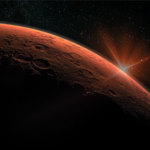The image depicts a concept art: a five meters tall titanium penetrator imbedded in the Martian soil. The scientific payload and cameras broadcasting statue’s selfies reside in the half-buried pedestal. Long after the science mission ends, this statue will serve as a landscape feature and a message to the future generations.
Cite as: Spacek, J. (2024) “IMPRESS to Deliver Art and Science to Mars .” Primordial Scoop, e20240920. https://doi.org/10.52400/PCFY7624
Almost a year ago I posted about kinetic penetrators that can deploy scientific equipment to the Martian subsurface at a much lower costly than traditional soft landing drilling platforms. At that time, I was convinced I made a brilliant discovery. However, after reading my post, Pete Klupar told me that these missions were planned since about 1970s and some were already flown to Mars.
It is always a bummer when someone steals my ideas, returns in time, and publishes them long before I was born. On the other hand, a copious literature covering the planetary penetrators informed me, that my (not) original idea was correct. Planetary penetrators and rough landers can indeed deliver scientific equipment to Mars surface and subsurface much less costly than traditional soft-landing missions. Planetary penetrators are an already developed and tried technology.
Scientists agree that the subsurface is the most desirable place to study on Mars. That’s why planned astrobiology Mars missions (Rosalind Franklin, Mars Life Explorer, and our ALF) rely on drilling platforms. In these missions, the soft landing and drilling consume a substantial portion of the available rocket payload and a substantial portion of the R&D budget.
By launching probes from Mars orbit without a soft lander, the Martian surface and near subsurface (down to ~50 m) becomes accessible to even small organizations. Thus, using commercially available Falcon Heavy, we could re-deliver each of the 2.5 kg Deep Space 2 probes to Mars for about $15,000. At this price even garage scientists can afford to send payload to Mars – provided the entire payload of Falcon Heavy is fully sold out.
The realization that I could fly a scientific probe to Mars at a lower cost than was a cost to remodel my bathrooms led to the IMPRESS mission concept which I first publicly presented during the 2024 AbSciCon.
IMPRESS stands for International Mars Penetrator Ride-Share System.
IMPRESS is based upon the belief that, if we announce that we are sending a Falcon Heavy to Mars in 2028, there will be a market to purchase the entire available payload for six dollars per gram. Many scientists would come up with really cool ideas and would find ways how to fund this.
The only conditions to be included in the IMPRESS mission is to (1) ensure that the provided payload is sterilized to the degree required by COSPAR Policy and (2) the participants need to pay their share of the payload. No other requirements are needed.
As there are no restrictions on the science instrumentation, this call is open to anyone who wants to have a payload delivered to Mars. To deliver a 1-ton titanium statue, designed to be partially imbedded in Mars regolith, would cost roughly $6 million dollars. For some, this is a small price to send a message to the future generations of humans living on Mars.
If the transport of these artworks is auctioned, perhaps the art part of the mission can pay for the delivery of the science part of the mission – or even for the development of the scientific instruments. (For reference the 3-year long development and deployment of Deep Space 2 mission cost $2 million dollars in 1999).
And perhaps artists and scientists can work together. The artists can get inspired by their local science team. The collaboration might be even more direct; a large statue (also serving as an antenna) can deploy scientific instruments from its ground penetrating pedestal. The statue will remain standing long after the mission is completed, becoming a permanent feature of the Martian landscape to be rediscovered by our descendants.
The IMPRESS will solicit contributions from every university around the world, engaging future explorers and artists.
The IMPRESS mission will start a conversation about our place in the universe in a way that is accessible to broad public and not just to academic philosophers and astrobiologists like myself.
There is a lot of science that must be conducted before we send humans to Mars in the 2030s. Let’s not delay the next big step of our journey by not completing this science on time. Let’s use the art to attract minds of students and philanthropists around the world to deploy unconventional tools to seek Martian life, to prospect local resources, and to identify risks and challenges that future generations of humans will have to face and overcome.
This all can be done with technology that exists today.
IMPRESS should launch for the first time in 2028.



